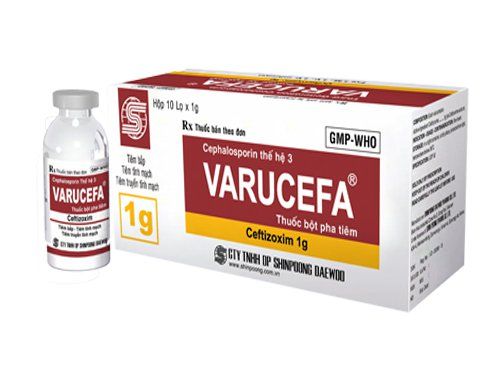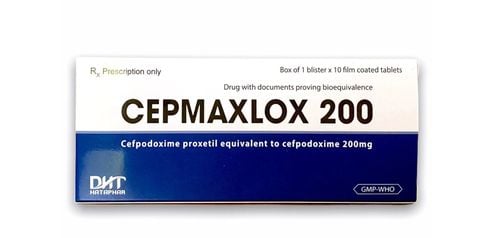This is an automatically translated article.
Biviminal is an antibiotic containing the active ingredient Ceftizoxime belonging to the 3rd generation cephalosporin group. The drug is used in the treatment of a number of infectious diseases such as respiratory, urinary-genital infections, skin infections and meningitis. ,...
1. What is Biviminal?
Biviminal medicine 2g contains the main ingredient is Ceftizoxime (in the form of Ceftizoxime sodium) 2000mg. This is a 3rd generation cephalosporin antibiotic known for its broad antibacterial spectrum, and is stable to hydrolytic enzymes secreted by bacteria.
Ceftizoxime's mechanism of action is similar to that of other cephalosporins, causing inhibition of cell wall synthesis leading to effective bacterial killing. Many research documents have shown that Ceftizoxime has strong activity in Gram-negative infections, typically bacteria such as Enterobacter spp., Haemophilus influenzae (including ampicillin-resistant strains), Klebsiella pneumoniae, Escherichia coli, Proteus vulgaris , Pseudomonas aeruginosa, Morganella morganii, Proteus mirabilis, Neisseria gonorrhoeae,...
In addition, Ceftizoxime is also capable of acting on some typical Gram-positive bacteria strains including Streptococcus pneumoniae, other Streptococcus (except enterococcus) , Staphylococcus aureus. In particular, Ceftizoxime is also active against a few anaerobic gram-negative bacilli such as Bacteroides spp, peptostreptococcus spp, Bacteroides fragilis and Peptococcus spp.
Because Ceftizoxime is not absorbed from the gastrointestinal tract, it is usually prepared as a powder for injection.
2. Indications and contraindications to the drug Biviminal
2.1. Indications Biviminal is indicated for use in the following cases:
Respiratory diseases such as pneumonia, lung infections, purulent pleurisy, bronchitis, bronchiectasis, secondary infections often appear present in patients with chronic lung disease. Diseases related to the urinary tract include nephritis, cystitis, urethritis. Diseases related to the gastrointestinal tract such as cholangitis, peritonitis, cholecystitis . Diseases related to the genital tract such as prostatitis, gonorrhea, endometritis, parametritis, pelvic infection patients. Some other diseases such as septicemia, meningitis, osteomyelitis, infective endocarditis, septic arthritis, post-traumatic infection, burns, cellulitis, tonsillitis, postoperative, inflammatory extra. 2.2. Contraindications Do not use Biviminal for patients with a history of allergy to penicillin and cephalosporin antibiotics.
3. Dosage and how to use Biviminal
3.1. Dosage Dosage Biviminal for adults and children over 12 years old:
Patients with uncomplicated infections: Use Biviminal with a dose of 2 vials/day, divided equally into each injection dose 12 hours apart. Patients with moderate to severe infections: Use Biviminal at a dose of 3 - 6 vials/day, equally divided into each injection dose with an interval of 8 hours. Patients with infections requiring high doses of antibiotics (sepsis): Use the drug at a dose of 6-8 vials/day, equally divided into each injection at 6-8 hours intervals Patients with life-threatening infections: Use medicine with 12 vials/day, divided equally into each dose 4 hours apart. Use of drugs to treat gonorrhea: Use a single dose intramuscularly. Dosage of Biviminal for infants and children under 12 years old
Depending on the infection status, the drug is used at a dose of 50-100 mg/kg/day, divided equally into each injection dose 6-12 hours apart. In some fatal infections, the dose may be increased to 150-200 mg/kg/day. The dose of Biviminal for premature infants should not exceed 50 mg/kg/day.
Patients with renal impairment need to reduce the dose if the creatinine clearance is less than 5 ml/min.
3.2. How to use Deep intramuscular injection: Should not be injected into the blood vessels, use 2g of the drug mixed with 6ml of distilled water for injection, shake well. Intravenous injection: Dissolve 2g Biviminal with 20ml distilled water for injection, shake well, then inject directly or slowly in 3-5 minutes. Continuous or intermittent intravenous infusion: Dissolve 2g of Biviminal in 20ml of distilled water for injection, further dilute with 50-100ml of 0.9% sodium chloride injection or 5% dextrose injection solution.
4. Side effects when using Biviminal
Biviminal has a risk of causing some of the following side effects:
Hematologic effects such as thrombocytopenia, eosinophilia, and leukopenia, hemolytic anemia Effects on the liver such as increased liver enzymes and transient bilirubin. Affects the kidneys causing impaired renal function, interstitial nephritis. Effects on the digestive system such as causing nausea, vomiting, abdominal pain, diarrhea, pseudomembranous colitis. Affects the cardiovascular system causing arrhythmias. Affects the skin causing painful inflammation at the injection site, urticaria, itchy rash.
5. Drug interactions
Biviminal may interact with some of the following drugs:
Concomitant use with polymyxin antibiotics may increase the risk of kidney damage. Concomitant use with azlocillin may cause brain damage and partial seizures in patients with renal failure. The clearance of cefotaxime is reduced if Biviminal is co-administered with azlociline or mezlociline.
6. Be careful when using Biviminal
Be careful when using Biviminal for people allergic to penicillin because there is a risk of cross-allergenicity between penicillin and cefotaxime. Renal function should be monitored when Biviminal is used concomitantly with potentially nephrotoxic drugs. Biviminal can cause false positives with the Coombs test, a method of testing the urinary tract. In the case of taking Biviminal, blood cells must be monitored, when neutropenia appears, the drug must be stopped immediately. Above is some basic information about Biviminal drug, readers should refer to know how to use it appropriately. If you have any doubts, ask your doctor for advice and support.
Follow Vinmec International General Hospital website to get more health, nutrition and beauty information to protect the health of yourself and your loved ones in your family.













